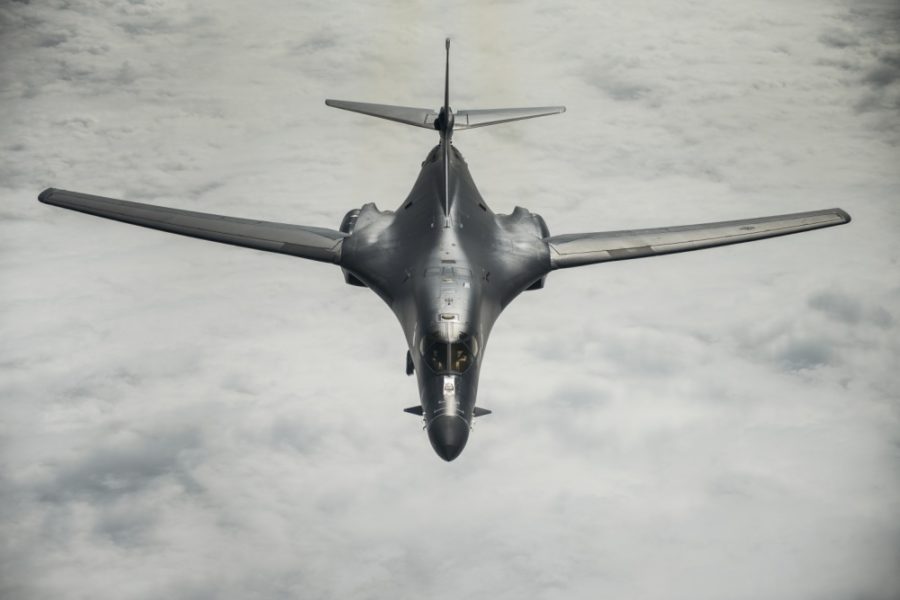The B-1B is a conventional, long-range, supersonic, penetrating strike aircraft derived from the canceled B-1A. The B-1A first flew on Dec. 23, 1974, and four prototypes were developed and tested before program cancellation in 1977.
The Reagan administration revived the program as the B-1B in 1981, adding 74,000 lb of usable payload, improved radar, and reduced radar cross section, but reducing speed to Mach 1.2.
Its three internal weapons bays can carry the largest payload of guided/unguided weapons in the Air Force inventory, and its blended wing/body and variable-geometry wing permit long-range/loiter time.
Offensive avionics include terrain-following SAR and a fully integrated Sniper ATP to track and target moving vehicles.
B-1B made its combat debut over Iraq during Desert Fox in 1998. The B-1B is USAF’s sole Long-Range Anti-Ship Missile (LRASM) carrier and its range, speed, and payload make it a key power-projection asset in USAF’s Indo-Asia Pacific strategy. The fleet completed its most comprehensive upgrade to date in September 2020. The three-part Integrated Battle Station (IBS) program added an all-digital glass cockpit, Fully Integrated Data Link (FIDL) to enhance targeting/LOS/BLOS C2, and a Central Integrated Test System (CITS) for real-time simplified troubleshooting.
FY25 launches Load Adaptable Modular (LAM) pylon installations to enable externally mounted long-range standoff, outsized hypersonic, or 5,000 lb-class guided weapons. LAM will expand the bomber capacity to 36 JASSM, LRASM, or developmental Hypersonic Attack Cruise Missiles (HACM ). Current development includes radio crypto modernization to enable transition to next-gen MUOS secure, jam-resistant BLOS SATCOM, and upgrades to replace the B-52 in the hypersonic weapons test role.
AFGSC retired the 17 least serviceable airframes to boost fleet readiness but is now regenerating two of the aircraft to replace damaged airframes. A third B-1B was severely damaged in a landing accident at Ellsworth in 2023, but AFGSC does not plan to replace it. Ellsworth B-1s relocated to Grand Forks in December 2024 to allow facility construction supporting transition to the B-21. B-1Bs will continue providing bomber capacity until fully replaced by the B-21, targeted for 2032.
B-1B Lancer Technical Data
Contractor: Boeing (formerly Rockwell International).
First Flight: Oct. 18, 1984.
Delivered: June 1985-May 1988.
IOC: Oct. 1, 1986, Dyess AFB, Texas.
Production: 104.
Inventory: 45.
Operator: AFGSC, AFMC.
Aircraft Location: Dyess AFB, Texas; Edwards AFB, Calif.; Eglin AFB, Fla.; Ellsworth AFB, S.D.
Active Variant: B-1B. Upgraded production version of the B-1A.
Dimensions: Span 137 ft (forward sweep) to 79 ft (aft sweep), length 146 ft, height 34 ft.
Weight: Max T-O 477,000 lb.
Power Plant: Four GE Aviation F101-GE-102 turbofans, each 30,780 lb thrust.
Performance: Speed 900+ mph at S-L, range approx. 7,455 miles (further with air refueling).
Ceiling: More than 30,000 ft.
Armament: 84 Mk 82 (500-lb) or 24 Mk 84 (2,000-lb) general-purpose bombs; 84 Mk 62 (500-lb) or eight Mk 65 (2,000-lb) Quickstrike naval mines; 30 CBU-87/89 cluster bombs or 30 CBU-103/104/105 WCMDs; 24 GBU-31 or 15 GBU-38 JDAMs/GBU-54 JDAM; 24 AGM-158A JASSM, JASSM-ER, or LRASM.
Accommodation: Pilot, copilot, and two WSOs (offensive/defensive), on ACES II zero/zero ejection seats.


